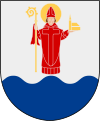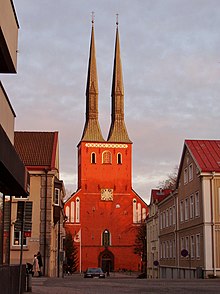Vaxjo
| Vaxjo | ||||
|
||||
| State : | Sweden | |||
| Province (län): | Kronobergs län | |||
| Historical Province (landskap): | Småland | |||
| Municipality : | Vaxjo | |||
| Coordinates : | 56 ° 53 ' N , 14 ° 48' E | |||
| SCB code : | 2024 | |||
| Status: | Crime scene | |||
| Residents : | 65,383 (December 31, 2015) | |||
| Area : | 35.41 km² | |||
| Population density : | 1846 inhabitants / km² | |||
| Height : | 167 m ö.h. | |||
| Telephone code : | (+46) 470 | |||
| Postal code : | 350 03 - 359 99 | |||
| List of perpetrators in Kronobergs län | ||||
Växjö [ ˈvɛkːˌɧøː ] is a university town in southern Sweden . The residential city is located in the historical province of Småland and is the capital of the province of Kronobergs län . Växjö is also the capital of the municipality of the same name and is considered the capital of the so-called " Kingdom of Glass ".
Until the beginning of the 20th century the common spelling of the city was Wäxiö .
geography
Växjö lies at the intersection of two lakes . The name probably originated from the Swedish words väg (way) and sjö (lake), since in winter the farmers came to the market across the frozen lake. The city is located in Värend , one of the many small countries in Småland, which, together with Njudung and Finnveden, was one of the larger ones. Värend corresponds roughly to the eastern two thirds of today's Kronoberg län . Helgasjön , north of the city, is one of the largest lakes in southern Sweden.
history
Växjö was already trading in the Iron Age . According to the Siegfried legend , the English missionary Sigfrid was the first Christian missionary to come to Värend and built the very first Värends church in Växjö. In 1170 this led to Växjö becoming a bishopric and henceforth a destination for many pilgrims . The city received city rights on February 13, 1342 from King Magnus Eriksson . There is evidence that there was a settlement at this point as early as the 11th century. Due to its location on the old border between Denmark and Sweden, the city was often devastated. B. 1276, 1570 and 1612, but could also benefit from border trade. The wooden town of Växjö burned down several times, including in 1799, 1838 and 1843.
tourism
In addition to extensive boat excursions, there are bike tours and hikes, visits to glass factories and castles. This branch of industry benefits from a wide range of accommodation.
The fact that the Irish low-cost airline Ryanair flies to Växjö / Kronoberg airport from Weeze on the Lower Rhine also offers tourists a new way of getting there. In addition, the Swedish airline Flysmåland has recently started flying from Berlin-Tegel and Kaunas (Lithuania) to Växjö.
Attractions
The city center is dominated by the 14th century cathedral , which has been extensively restored several times over the centuries. There is a rune stone on its east side . Linné Park extends south of the cathedral . There are several museums in Växjö , including the Utvandrarnas Hus , which documents the Swedish emigration in the 19th century , and the Swedish Glass Museum (part of Smålands Museum). Teleborg Castle, located on the university campus, is located in the Teleborg district , a historic building from 1900. The Kronoberg Castle ruins , five kilometers north of the city , are also worth seeing .
economy
Växjö is the central shopping town and forms the administrative center of the region with the provincial administration and the bishopric. The University of Växjö also created jobs in the academic field. The glass industry is represented by the glass research institute Glafo . Due to the location in wooded areas, forestry was once an important industry. This is made clear by the headquarters of Södra Skogsägarna , an association of forest owners in Götaland . The airline Flysmåland is based in Växjö. Since 1993 the city has reduced its CO 2 emissions by around 30% and has thus taken on a pioneering role in Sweden.
education
The University of Växjö merged with the Kalmar University of Applied Sciences to form Linné University in 2010 . The university continues to operate a campus in Växjö. The largest wooden house in Sweden is on campus.
Personalities
sons and daughters of the town
The following famous personalities were born in Växjö and the surrounding area:
- Jonas Björkman , tennis player
- Karl-Birger Blomdahl , composer
- Nina Canell , sculptor and installation artist
- Tom Englén , beach volleyball player
- Pär Gerell , table tennis player
- Carl-Henrik Heldin , molecular biologist
- Johan Hörlén , jazz musician
- Stefan Johansson , racing car driver
- Jonas Jonasson , writer
- Jonas Källman , handball player
- Perseus Karlström , walker
- Pär Lagerkvist , author and winner of the 1951 Nobel Prize in Literature
- Otto Lindblad , composer
- Agi Yngve Ivar Lindgren (1908–1988), teacher, professor of German studies and medical historian, was born in Braås 30 km outside the city
- Kristina Nilsson , soprano, was born in Vederslöv 15 km outside the city
- Fredrik Peterson , beach volleyball player
- Christian Quadflieg , German actor
- Thomas Ravelli , soccer player
- Ulf Wallin , violinist
- Mats Wilander , tennis player, born in Moheda 20 km outside the city
- Therese Willstedt (* 1984), director and choreographer
- Björn Werdenheim , racing car driver
- Anton Zetterholm , musical actor
The members of the following rock and pop bands come from Växjö:
Personalities who have worked in the city
- Alfred Gustaf Ahlqvist , Swedish historian
- Carl von Linné , attended grammar school here
- Esaias Tegnér (1782–1846)
- Carolina Klüft
- Ragnar Skanåker , seven-time Olympian in sport shooting
- Henning Mankell was theater director and general manager of Kronbergs Theater in Växjö in the 1980s
Twin cities
Växjö lists the following nine town partnerships :
| city | country | since |
|---|---|---|
| Aabenraa |
|
|
| Almere |
|
1999 |
| Duluth |
|
1987 |
| Kaunas |
|
1990 |
| Lancaster |
|
1996 |
| Lohja |
|
|
| Pobiedziska |
|
1991 |
| Ringerike |
|
|
| Schwerin |
|
1997 |
| Skagastrond |
|
Web links
- vaxjo.se , official website
- Page about the cathedral
supporting documents
- ↑ a b Statistiska centralbyrån : Land area per Tatort, folkmängd and invånare per square kilometer. Vart femte år 1960 - 2015 (database query)
- ↑ Terry Slavin: What can the world learn from Växjö, Europe's self-styled greenest City? theguardian.com, November 25, 2015, accessed November 25, 2015
- ^ This is Linnaeus University. In: LNU.se (English).
- ^ Vanorter. (No longer available online.) Archived from the original on October 3, 2016 ; accessed on October 3, 2016 . Info: The archive link was inserted automatically and has not yet been checked. Please check the original and archive link according to the instructions and then remove this notice.



